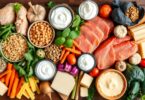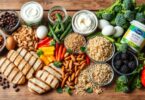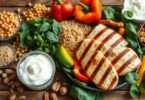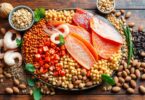As the sun rises, Anna feels a surge of energy. She attributes her vibrant health and boundless vitality to her dietary choices. Today, she’s set to explore the top 10 protein-rich foods that can revolutionize her well-being.
Protein is the cornerstone of life, crucial for a strong, resilient body. It supports muscle growth and repair, regulates hormones, and boosts immunity. This macronutrient is pivotal for our health and fitness. We will delve into the best protein-rich foods, revealing their unique nutritional profiles and the remarkable benefits they offer.
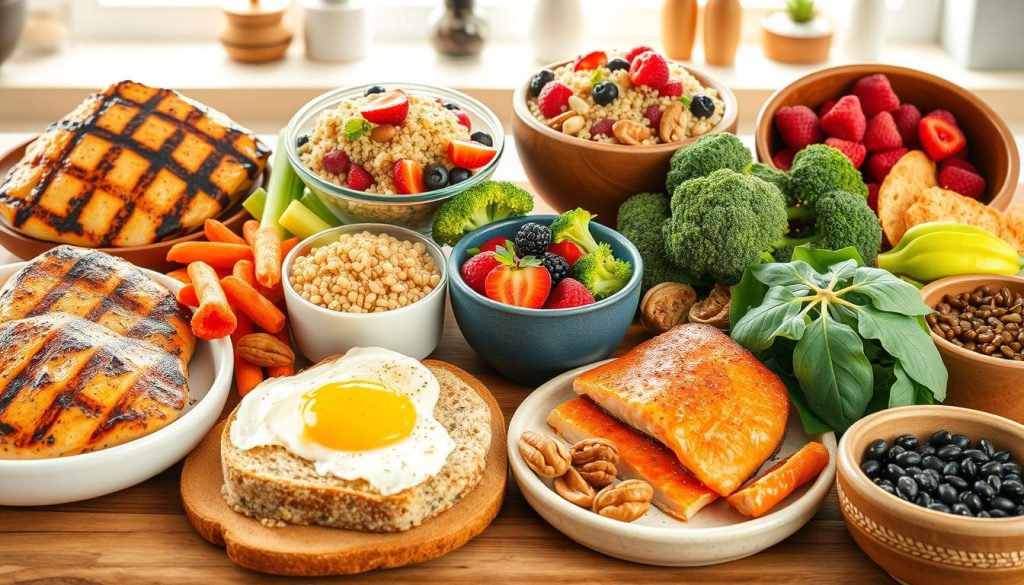
Key Takeaways
- Protein-rich foods are essential for building and maintaining a healthy body.
- Lean meats, eggs, fish, and dairy products are excellent sources of high-quality protein.
- Vegetarians and vegans can find protein in plant-based options like quinoa, legumes, and protein powders.
- Incorporating a variety of protein-rich foods into your diet can provide a range of essential nutrients.
- Proper protein intake can support muscle growth, weight management, and overall well-being.
Understanding the Importance of Dietary Protein
Protein, a vital macronutrient, is indispensable for our health and well-being. It is crucial for muscle building and repair, as well as for regulating bodily functions. Knowing the essential functions of protein and the daily needs for different age groups is key. This knowledge ensures you meet your protein requirements for health, fitness, and energy.
Essential Functions of Protein in the Body
Protein is fundamental to various bodily processes. It is a critical component of muscles, organs, and tissues, aiding in their construction, maintenance, and repair. Additionally, it supports the immune system, facilitates hormone and enzyme production, and is essential for nutrient transport.
Daily Protein Requirements for Different Age Groups
- Children (4-8 years): 19-24 grams per day
- Teens (14-18 years): 52-71 grams per day
- Adults (19-70 years): 46-56 grams per day
- Older adults (over 70 years): 56-69 grams per day
Signs of Protein Deficiency
Inadequate protein intake can result in several health issues. Common symptoms include muscle loss, a weakened immune system, slow wound healing, edema, and hair loss. It is crucial to meet your daily protein needs to maintain optimal health and avoid these deficiency-related problems.
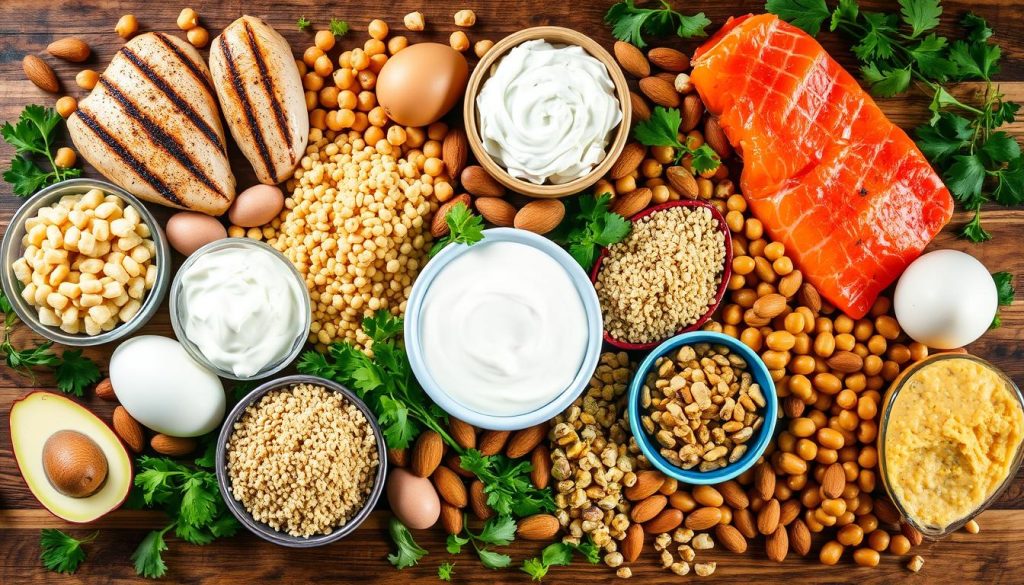
“Protein is the building block of life, and it’s essential for maintaining a healthy, active lifestyle.”
Lean Meats: The Ultimate Protein Powerhouse
Lean meats stand as the pinnacle of protein sources, crucial for muscle development and a balanced lifestyle. These foods are not only rich in high-quality protein but also packed with vital vitamins and minerals. They play a pivotal role in enhancing overall health and well-being.
Lean cuts of beef, pork, and poultry are the epitome of protein for muscle gain. Each serving is a significant source of this macronutrient. Moreover, their low-fat content makes them ideal for those aiming to foods with protein while keeping calorie intake in check.
To fully harness the benefits of protein-packed foods, it’s imperative to diversify your lean meat intake. Popular options include:
- Chicken breasts
- Turkey breast
- Lean ground turkey
- Sirloin steak
- Pork tenderloin
By integrating these lean meats into a diet rich in fruits, vegetables, and whole grains, you can craft a nutrient-dense regimen. This regimen supports muscle growth, aids in weight management, and promotes overall health.
| Lean Meat | Protein Content (per 4 oz serving) |
|---|---|
| Chicken Breast | 26 grams |
| Lean Ground Turkey | 20 grams |
| Pork Tenderloin | 22 grams |
| Sirloin Steak | 24 grams |
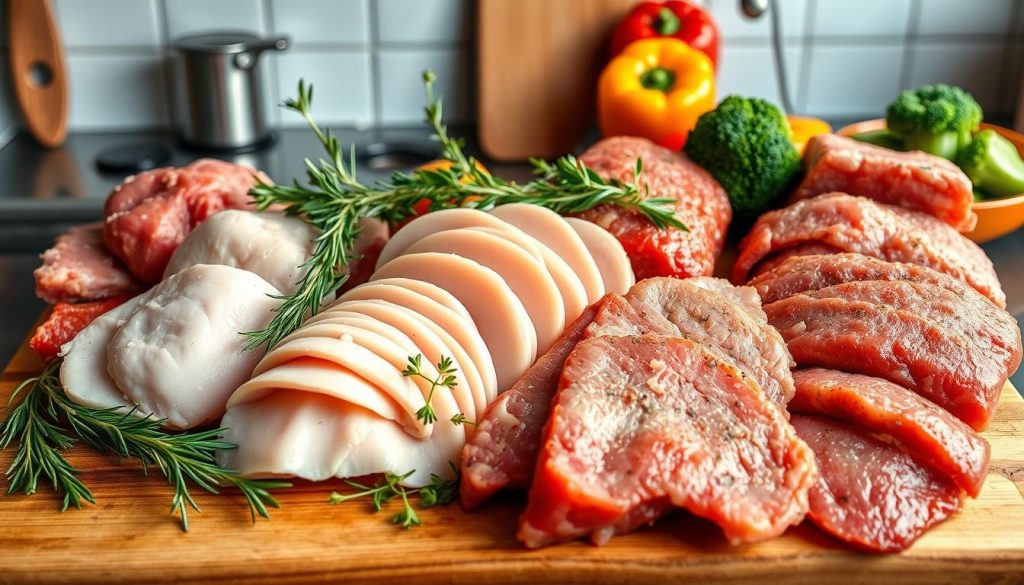
Integrating these lean meats into your diet is a strategic move to elevate your daily protein intake. This is particularly beneficial for those aiming to build muscle, maintain a healthy weight, or enhance overall well-being. Thus, lean meats should be a fundamental component of your dietary plan.
Eggs: Nature’s Perfect Protein Package
Eggs are celebrated as nature’s quintessential protein source. They are replete with essential nutrients, providing a balanced nutritional profile that solidifies their status as a premier protein-rich breakfast or snack option. Their protein content is not the only advantage; eggs also offer a plethora of health benefits that transcend mere muscle enhancement.
Nutritional Profile of Eggs
A single large egg harbors about 6 grams of high-quality, complete protein. Eggs are also a treasure trove of vitamins A, D, E, and B12, along with minerals such as iron, phosphorus, and selenium. Furthermore, egg yolks are a rich source of choline, a vital nutrient for brain health and cognitive function.
Creative Ways to Include Eggs in Your Diet
- Scrambled, fried, or poached eggs for breakfast
- Hard-boiled eggs as a portable protein-rich snack
- Omelets or frittatas loaded with vegetables
- Eggs benedict with a hollandaise sauce
- Egg salad or deviled eggs for a protein-packed lunch
Health Benefits Beyond Protein
Eggs offer more than just a protein boost; they are also a treasure trove of additional health benefits. The antioxidants in egg yolks, such as lutein and zeaxanthin, may protect the eyes from age-related macular degeneration and cataracts. Eggs also contain choline, a nutrient essential for skin health, liver function, and brain development.
Whether you’re aiming to fuel your workout, kickstart your day with a nutritious breakfast, or simply enhance your diet with high-quality protein, eggs stand out as a versatile and economical choice. They should be a cornerstone in your refrigerator.
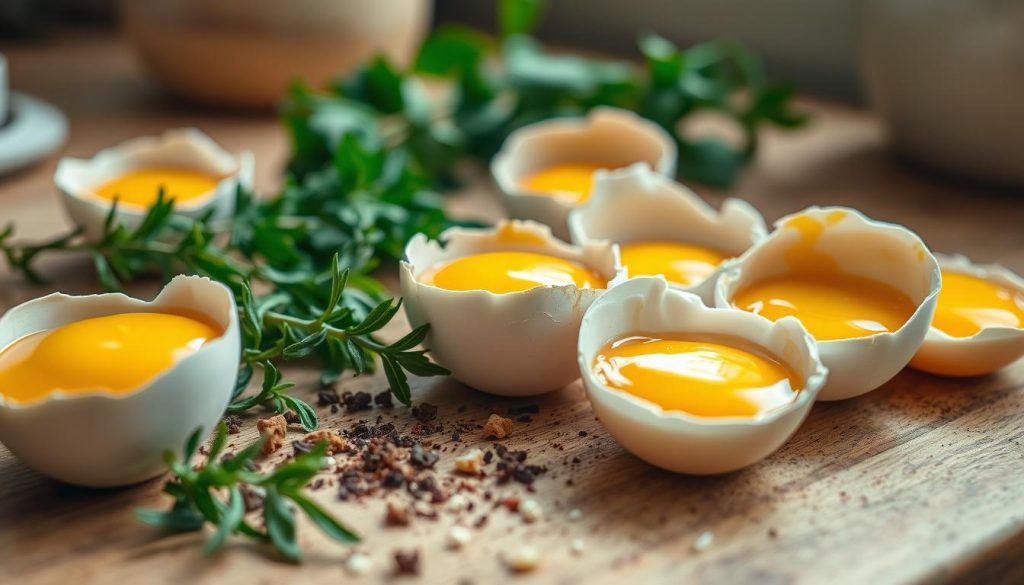
Fish and Seafood: Omega-Rich Protein Sources
Fish and seafood stand out as premier protein sources, offering not only high-quality protein but also a wealth of additional health benefits. Their nutritional profile is unmatched, making them a cornerstone in a balanced diet.
The omega-3 fatty acids found in fish and seafood are particularly noteworthy. These essential fatty acids are crucial for heart health, inflammation reduction, and brain function. With a variety of options ranging from fatty fish like salmon and mackerel to lean choices like tilapia and cod, there’s a seafood for every dietary need.
These foods also play a significant role in weight management. The protein they contain promotes satiety, aiding in weight loss or maintenance efforts. Incorporating them into your diet can be a strategic move towards achieving your weight goals.
Furthermore, the protein and omega-3s in fish and seafood are beneficial for hair and skin health. These nutrients enhance the vitality of your hair, skin, and nails, contributing to a radiant and youthful appearance.
| Fish/Seafood | Protein (g per 100g) | Omega-3s (mg per 100g) |
|---|---|---|
| Salmon | 27 | 2,260 |
| Tuna | 26 | 200 |
| Shrimp | 24 | 123 |
| Cod | 18 | 184 |
| Tilapia | 26 | 123 |
For those aiming to enhance their protein intake, support heart health, or nourish their hair and skin, fish and seafood are an exemplary choice. By integrating these omega-rich protein sources into your diet, you can experience a nutritional boost that promotes overall well-being.
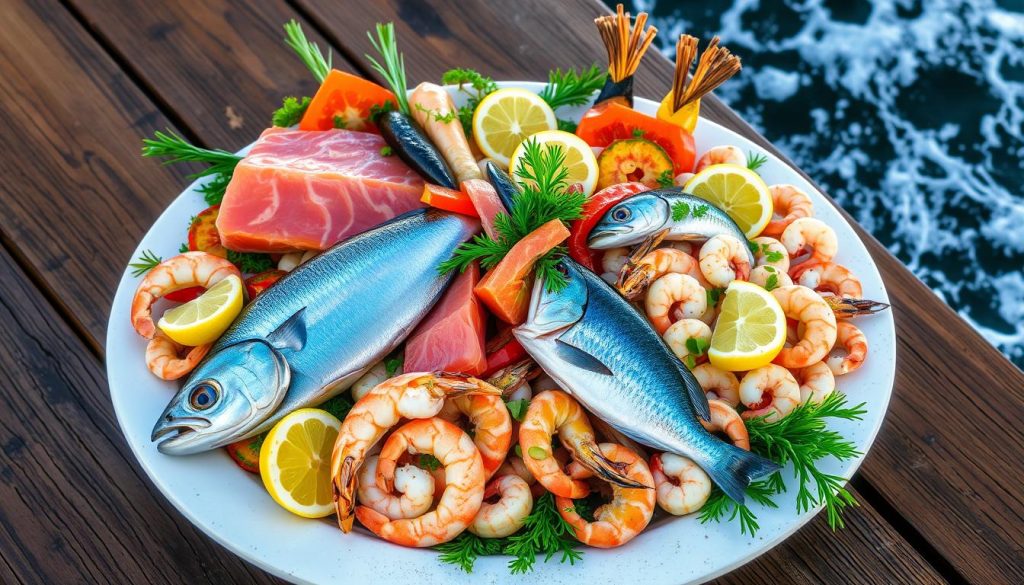
“Seafood is one of the most versatile and nutritious protein sources available. It’s a win-win for your health and your taste buds.”
Greek Yogurt and Cottage Cheese: Dairy Protein Champions
Dairy products stand out as the pinnacle of protein-rich snacks. Greek yogurt and cottage cheese, in particular, are champions, offering a substantial protein boost that supports health and fitness objectives.
Comparing Different Dairy Protein Sources
Greek yogurt surpasses regular yogurt with its higher protein content, delivering up to 20 grams per serving. Conversely, a half-cup of cottage cheese contains approximately 15 grams of high-quality dairy protein. These dairy products outshine many snacks, making them ideal for women aiming to enhance their metabolism.
Probiotic Benefits of Fermented Dairy
Moreover, Greek yogurt and cottage cheese provide probiotic advantages. The fermentation process introduces beneficial gut bacteria, enhancing digestive health and immune function. For women desiring to optimize their well-being, these protein-rich foods for metabolism are unparalleled.

Seeking a nutritious protein-rich snack or looking to increase dairy products in your diet? Greek yogurt and cottage cheese are versatile, delivering a significant protein punch. Incorporating these protein for women into your regimen fuels your body and supports health in delicious, convenient ways.
Protein-Rich Foods for Vegetarians and Vegans
Adhering to a plant-based regimen necessitates a diligent search for plant-based proteins. Fortunately, a plethora of high-protein vegetarian foods and high-protein vegan foods are available, ensuring one’s protein intake is met.
Legumes, including lentils, beans, and chickpeas, stand out as premier protein food sources for vegetarians. They are replete with fiber, complex carbohydrates, and a spectrum of vital vitamins and minerals. Pairing legumes with whole grains, such as quinoa or brown rice, results in a complete protein, furnishing all requisite amino acids.
- Lentils: A versatile and affordable legume that can be used in soups, stews, and vegetarian chili.
- Kidney beans: High in protein and fiber, perfect for vegetarian tacos or burritos.
- Chickpeas: Also known as garbanzo beans, can be roasted, added to salads, or blended into hummus.
Nuts and seeds emerge as another formidable source of plant-based proteins. Almonds, walnuts, chia seeds, and hemp seeds are all nutrient-dense options, suitable for snacking or meal integration. Tofu, tempeh, and edamame are also favored high-protein vegan foods, offering a protein-rich alternative to meat.
“Incorporating a variety of plant-based proteins into your diet is key to maintaining adequate protein intake on a vegetarian or vegan diet.”
By prioritizing these nutrient-dense, protein-rich foods for vegetarians and vegans, one can guarantee protein sufficiency while indulging in a diverse, plant-centric diet.
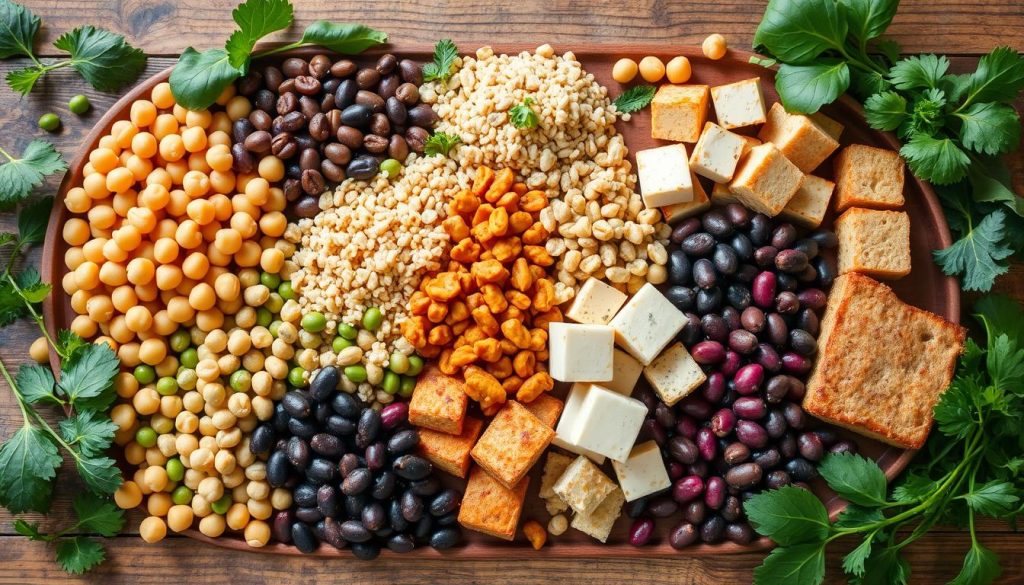
Quinoa and Ancient Grains: Complete Protein Sources
Quinoa and ancient grains emerge as the epitome of grains with a significant protein content. These foods are not only a treasure trove of protein and fiber but also a source of essential vitamins, minerals, and plant compounds. Their inclusion in protein-rich meals for lunch and dinner offers substantial health benefits.
Cooking Tips for Perfect Quinoa
Quinoa, a grain of versatility, cooks rapidly and effortlessly. To achieve a fluffy texture, it is crucial to rinse the quinoa thoroughly to eliminate any bitter-tasting saponins. A 1:2 ratio of quinoa to water or broth is recommended. Bring to a boil, then reduce heat and simmer for 15-20 minutes until the quinoa is tender and the liquid is absorbed. Afterward, fluff with a fork and allow it to rest for a few minutes before serving.
Ancient Grain Protein Comparison
- Quinoa: 8 grams of protein per cooked cup
- Amaranth: 9 grams of protein per cooked cup
- Teff: 10 grams of protein per cooked cup
- Buckwheat: 6 grams of protein per cooked cup
These ancient grains are not only rich in protein and fiber but also in other beneficial nutrients. They are ideal for protein-rich meals at any time of the day.
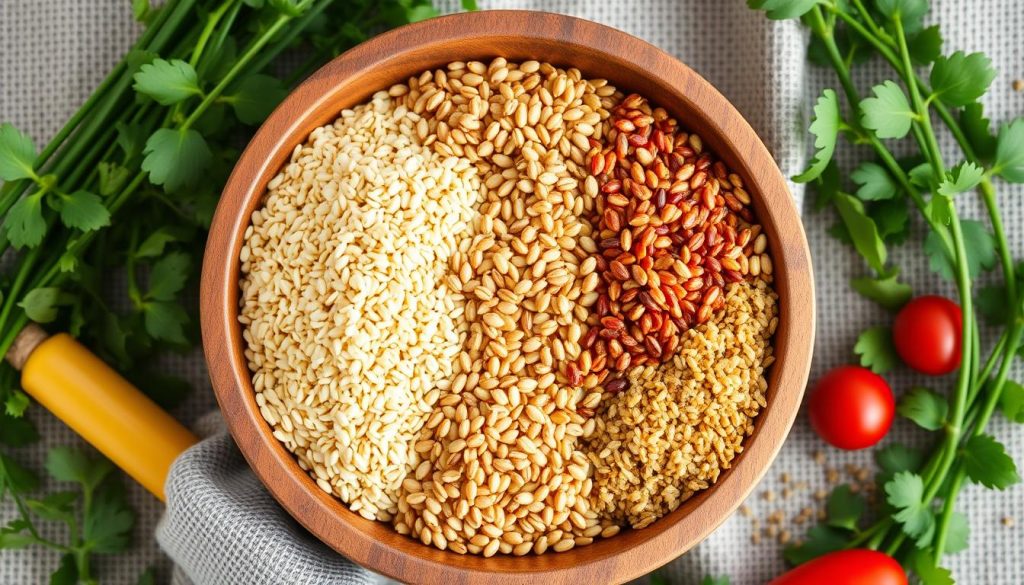
Integrate quinoa and other ancient grains into your diet by incorporating them into soups, salads, pilafs, and even baked goods. Their versatility and nutritional profile make them invaluable for protein-rich meals for lunch and dinner.
Nuts and Seeds: Portable Protein Snacks
Nuts and seeds stand out as formidable allies in the quest for convenient, high-protein snacks. These versatile entities are not only a treasure trove of nutritional benefits but also serve as a cornerstone for enhancing one’s health and energizing their daily routine.
Rich in protein, nuts and seeds emerge as the quintessential on-the-go snack for individuals in pursuit of a fulfilling and wholesome treat. From almonds and walnuts, which are replete with protein, to chia and flax seeds, which are dense with nutrients, these portable protein sources are adept at satiating hunger, aiding in weight management, and delivering a wealth of essential vitamins and minerals.
Protein-Rich Nuts and Seeds
- Almonds: With 6 grams of protein per 1-ounce serving, almonds are a fantastic choice for a protein-packed snack.
- Pumpkin seeds: Also known as pepitas, pumpkin seeds boast 5 grams of protein per serving and are packed with healthy fats, fiber, and minerals.
- Chia seeds: These tiny but mighty seeds pack a punch with 4 grams of protein per tablespoon, making them a great addition to smoothies, yogurt, or baked goods.
- Pistachios: Offering 6 grams of protein per 1-ounce serving, pistachios are a tasty and satisfying snack option.
| Nuts and Seeds | Protein (g per serving) | Calories (per serving) | Fat (g per serving) |
|---|---|---|---|
| Almonds | 6 | 163 | 14 |
| Pumpkin Seeds | 5 | 151 | 13 |
| Chia Seeds | 4 | 138 | 9 |
| Pistachios | 6 | 159 | 13 |
Integrating these protein-rich nuts and seeds into your diet can revolutionize your approach to nutrition, whether your goal is to shed pounds, build muscle, or simply maintain a balanced and nutritious lifestyle. Their versatility allows for a myriad of uses, from crunchy snacks to enriching your meals with their dense nutritional profile. The possibilities are boundless when embracing these portable protein powerhouses.
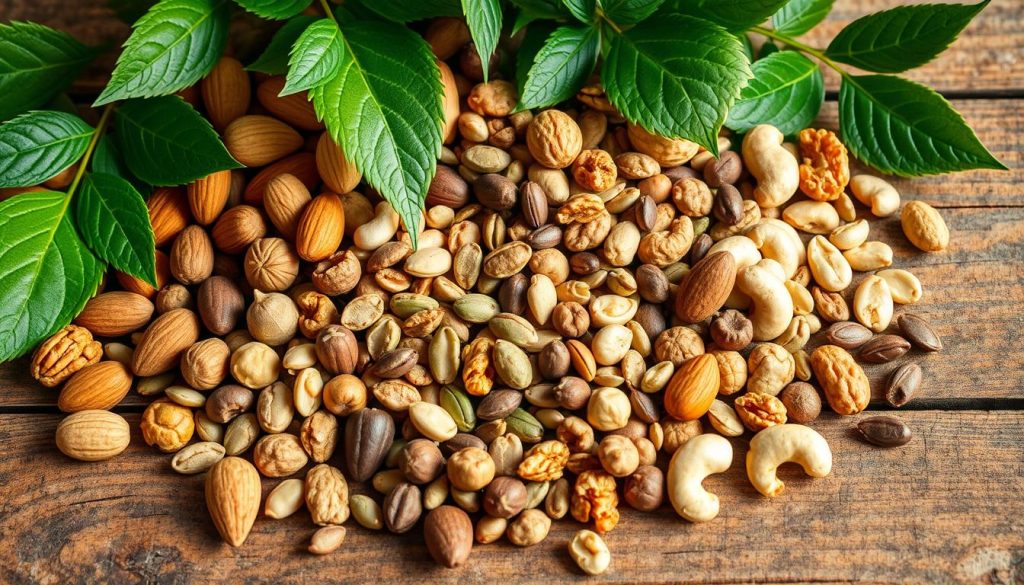
“Nuts and seeds are nature’s way of showing us that good things come in small packages.”
Legumes: Budget-Friendly Protein Options
Legumes stand out as a cost-effective and nutrient-dense protein source. These plant-based foods, encompassing beans, lentils, peas, and chickpeas, are rich in essential amino acids. This makes them an indispensable component of any protein food list or bodybuilding regimen. Moreover, legumes offer a plethora of health benefits, notably enhancing immune system strength.
Best Cooking Methods for Legumes
Optimal nutrient extraction from legumes necessitates the correct cooking methods. Soaking dried legumes beforehand can diminish antinutrients and enhance nutrient assimilation. Boiling or simmering legumes until they are tender is a traditional method. Pressure cooking, on the other hand, is a time-efficient alternative. Enhancing legume flavor and nutritional value can be achieved by seasoning them with herbs, spices, and aromatic vegetables.
Combining Legumes for Complete Protein
- Legumes, although a good plant-based protein source, often lack one or more essential amino acids, rendering them incomplete proteins. By mixing different legumes, one can achieve a complete protein profile, encompassing all necessary amino acids.
- For instance, combining lentils with rice or beans with corn creates a meal with a balanced amino acid composition. This results in a more comprehensive protein-rich meal.
- Integrating a variety of legumes into one’s diet is an effective strategy to increase protein intake. It also allows one to enjoy the numerous health benefits these versatile foods provide.
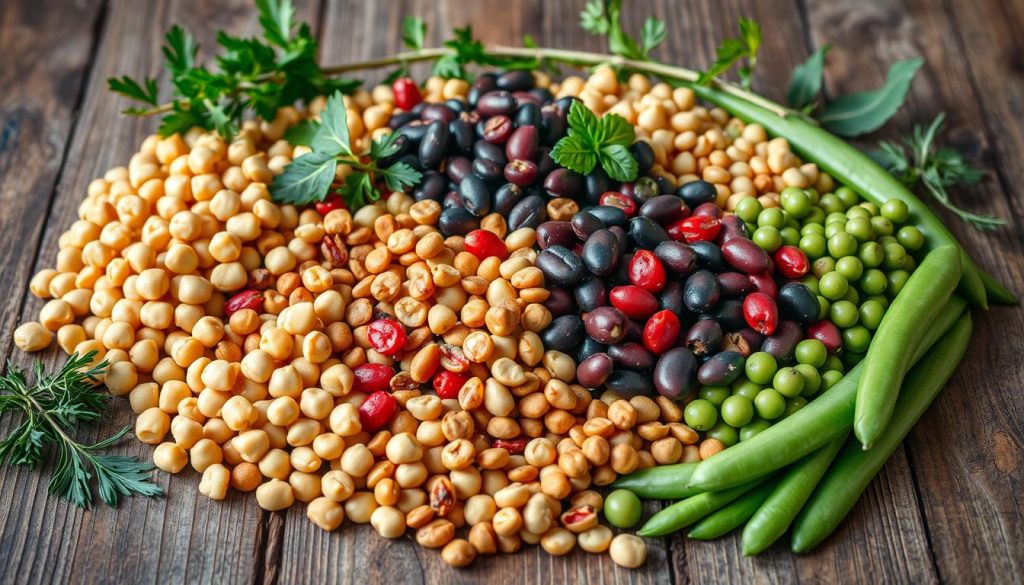
“Legumes are a budget-friendly way to increase your protein intake and support overall health.”
Plant-Based Protein Powders and Supplements
In today’s health-conscious world, plant-based protein powders and supplements have emerged as popular choices for those seeking to boost their protein intake. These innovative products not only cater to vegetarians and vegans but also appeal to fitness enthusiasts and those looking to support their active lifestyles.
When it comes to protein supplements, plant-based options offer a diverse array of benefits. Not only are they often packed with high-quality protein for men, but they also provide a range of essential nutrients, making them an excellent choice for protein food for recovery and supporting overall well-being.
Exploring the Plant-Based Protein Landscape
The plant-based protein market is brimming with a wide variety of options, from classic protein-rich smoothies made with pea, soy, or hemp protein to more exotic sources like spirulina and chlorella. Each type of plant-based protein offers its unique nutritional profile, allowing individuals to tailor their supplement choices to their specific dietary needs and preferences.
| Protein Source | Protein Content (per serving) | Key Benefits |
|---|---|---|
| Pea Protein | 20-30 grams | Hypoallergenic, easy to digest, rich in branched-chain amino acids |
| Soy Protein | 15-25 grams | Complete protein, contains isoflavones with potential health benefits |
| Hemp Protein | 12-20 grams | High in omega-3 and omega-6 fatty acids, easy to digest, contains fiber |
| Spirulina | 4-7 grams | Nutrient-dense, high in antioxidants, supports immune function |
When incorporating plant-based protein supplements into your diet, it’s essential to consider factors such as taste, texture, and overall nutritional content to find the right fit for your lifestyle and preferences.
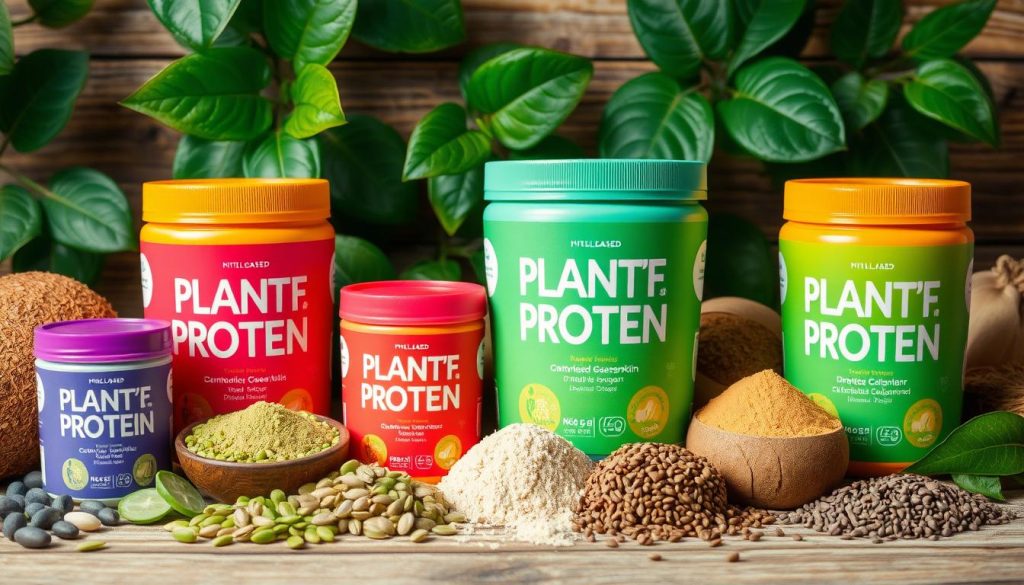
By exploring the vast array of plant-based protein options, individuals can tailor their supplement regimen to support their fitness goals, promote recovery, and maintain a balanced, nutrient-rich diet.
Meal Planning with High-Protein Foods
Incorporating high-protein meals into your daily diet can revolutionize your health and fitness objectives. Whether aiming to enhance muscle mass, support weight management, or maintain a balanced lifestyle, strategic meal planning with protein-rich foods is paramount. This section delves into sample meal plans and the significance of protein timing for optimal benefits.
Sample Meal Plans
To initiate your journey, we present several sample meal plans centered around high-protein foods:
- Breakfast: Scrambled eggs with spinach, whole-grain toast, and a side of Greek yogurt.
- Lunch: Grilled salmon salad with mixed greens, quinoa, and roasted vegetables.
- Snack: Cottage cheese with fresh berries and a handful of almonds.
- Dinner: Baked chicken breast with roasted sweet potatoes and steamed broccoli.
Protein Timing for Maximum Benefits
Optimizing your protein intake throughout the day can significantly enhance the benefits of a high-protein diet. Aim to consume a protein-rich meal or snack every 3-4 hours to support muscle recovery, growth, and overall metabolic health. Include high-protein meals like lean meats, eggs, or plant-based protein sources such as legumes and quinoa in your diet.
By meticulously planning your meals and snacks around protein-packed meals and strategic protein timing, you can ensure your body receives the essential nutrients it needs to flourish. Explore a variety of healthy high-protein recipes to maintain an engaging and fulfilling protein diet plan.
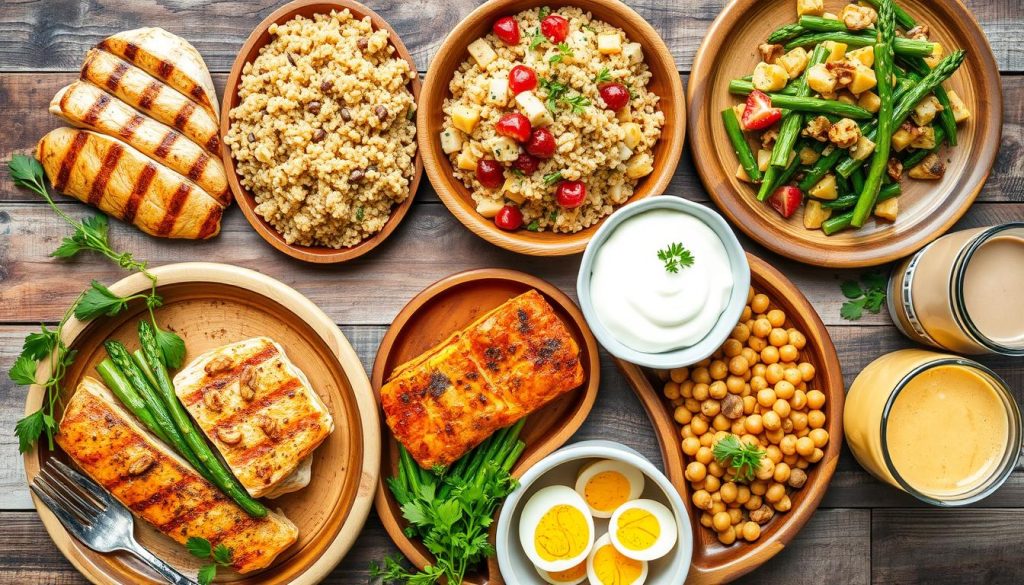
Common Myths About Protein Consumption
Protein is often misunderstood, leading to misconceptions that can impede our comprehension of its benefits. This section aims to address and refute prevalent myths surrounding protein intake.
Myth 1: Protein Causes Weight Gain
Contrary to widespread belief, protein does not inherently lead to weight gain. Instead, protein for weight loss can be a valuable asset. It aids in feeling fuller for longer, which can prevent overeating and support a healthy calorie deficit for weight management.
Myth 2: Protein Causes Digestive Issues
Protein for improving digestion is frequently overlooked. While some may experience temporary discomfort from increased protein intake, this is generally due to adjusting to higher levels. Proper hydration and gradual increases in protein-rich foods can help mitigate any digestive challenges.
Myth 3: High-Protein Diets Are Unhealthy
Well-balanced, protein-rich diets can significantly benefit overall health. When combined with a variety of nutrient-dense foods, higher protein intakes can support muscle growth, maintenance, and recovery. They also boost metabolism and promote protein foods for weight gain.
“Protein is an essential macronutrient, and consuming adequate amounts is crucial for optimal health and body composition.”
By dispelling these common myths, you can confidently incorporate more protein-rich foods into your diet. This will allow you to enjoy the numerous benefits for your overall well-being.

Tips for Incorporating More Protein in Your Diet
Attaining health and fitness objectives necessitates a deliberate effort to augment protein consumption. Whether your aim is to enhance muscle mass, manage weight, or elevate overall health, integrating more protein-rich foods into your regimen can significantly impact your progress. Here are some practical strategies to initiate this journey:
- Prioritize Lean Meats: Opt for lean cuts of chicken, turkey, and red meat, which are superior protein sources. Incorporate them into your daily meals to fulfill your protein requirements.
- Embrace Eggs: Eggs, being both versatile and economical, serve as an excellent protein option. Enjoy them for breakfast, incorporate them into baked goods, or use them as a quick snack.
- Explore Plant-Based Proteins: For vegetarians and vegans, options like quinoa, lentils, beans, and tofu offer substantial plant-based protein, catering to dietary needs.
- Snack on Nuts and Seeds: Nuts and seeds, being portable and protein-rich, can be seamlessly integrated into your daily routine. Maintain a supply for a rapid protein boost.
- Supplement with Protein Powders: Protein powders, whether whey or plant-based, serve as a convenient means to elevate protein intake, especially when complemented by a balanced diet.
By adapting your eating habits and integrating these protein-rich foods into your diet, you can supply your body with the necessary nutrients to support your fitness goals, weight management, and overall health and well-being.
| Food | Protein Content (per serving) |
|---|---|
| Grilled Chicken Breast | 54g |
| Scrambled Eggs | 13g |
| Lentils | 18g |
| Almonds | 6g |
| Whey Protein Powder | 24g |
The essence of a balanced and healthy diet lies in the inclusion of a variety of protein-rich foods from diverse sources. This approach ensures you meet your individual protein needs and supports your overall well-being.
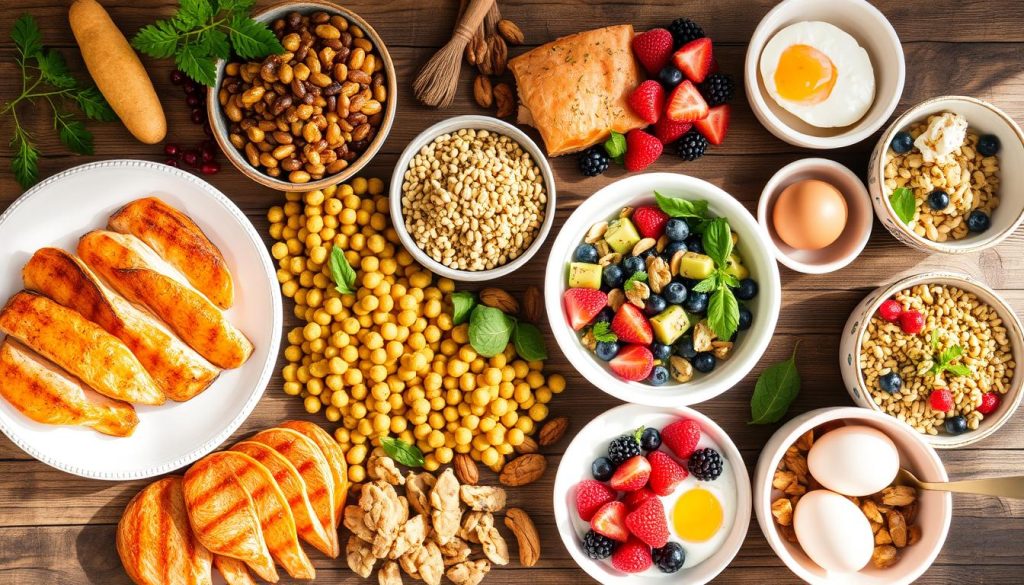
“Protein is the building block of our bodies, and it’s essential for maintaining muscle mass, promoting recovery, and supporting overall health.”
Conclusion
In the pursuit of a healthier, more robust physique, the inclusion of a diverse array of protein-rich foods in your diet is crucial. This encompasses lean meats, eggs, seafood, dairy products, and plant-based alternatives. These natural, protein-dense options are essential for fulfilling your daily protein requirements.
Whether aiming to enhance muscle mass, maintain strength, or bolster overall health, a diet balanced with high-quality proteins is transformative. Delving into the realm of foods rich in protein for bodybuilding, protein-rich foods for strength, and natural protein-rich foods enables the creation of both delectable and nutritious meals. These meals serve as the fuel for your body, ensuring its continued vitality.
Embarking on the path to enhanced health, it is imperative to recognize the significance of protein variety and quality. By selecting a broad spectrum of natural, whole-food proteins, you unlock the full potential of this critical nutrient. This approach will undoubtedly elevate your fitness and wellness to unprecedented levels.
FAQ
What are the best protein-rich foods to boost my health?
Opt for lean meats, eggs, fish, and seafood for high-quality protein. Greek yogurt, cottage cheese, and quinoa are also excellent choices. Nuts, seeds, and legumes provide additional nutrients. These foods are rich in vitamins, minerals, and healthy fats, enhancing overall health.
How much protein do I need daily, and what are the signs of protein deficiency?
Daily protein needs vary by age, activity level, and health status. Adults generally require 0.8 to 1.2 grams of protein per kilogram of body weight. Signs of deficiency include muscle loss, weakened immunity, slow wound healing, and fatigue.
What are the benefits of incorporating lean meats into my diet?
Lean meats offer high-quality protein, supporting muscle growth and boosting metabolism. They also provide sustained energy. Rich in iron, zinc, and B vitamins, lean meats are a nutrient-dense option.
Why are eggs considered a complete protein source, and how can I include them in my diet?
Eggs are complete proteins, containing all essential amino acids. They are versatile, suitable for various dishes like scrambled, boiled, or baked into omelets and frittatas.
What are the benefits of incorporating fish and seafood into my diet?
Fish and seafood are rich in protein and omega-3 fatty acids, supporting heart health and brain function. They are low in saturated fat, aiding in weight management.
How do Greek yogurt and cottage cheese compare to other dairy protein sources?
Greek yogurt and cottage cheese are high in protein and contain probiotics for gut health. They have a higher protein content than regular yogurt, making them ideal for boosting protein intake.
What are some protein-rich options for vegetarians and vegans?
Vegetarians and vegans can find protein in tofu, tempeh, seitan, beans, lentils, quinoa, nuts, and seeds. Combining these sources provides complete proteins with essential amino acids.
How can I incorporate quinoa and other ancient grains into my diet for a protein boost?
Quinoa and ancient grains like amaranth, buckwheat, and teff are complete proteins. Enjoy them as a side dish, in salads, soups, or as a base for protein-rich bowls and casseroles.
What are the benefits of incorporating nuts and seeds into my diet as protein-rich snacks?
Nuts and seeds are portable, nutrient-dense protein sources. They offer healthy fats, fiber, and vitamins and minerals, aiding in weight management and overall health.
How can I incorporate more protein-rich legumes into my diet?
Legumes, such as beans, lentils, and chickpeas, are budget-friendly and versatile. Enjoy them in soups, stews, salads, or as a side dish. Soaking and rinsing can enhance their nutritional value.
What are the benefits of using plant-based protein powders and supplements?
Plant-based protein powders and supplements are convenient for boosting protein intake. They support muscle recovery, weight management, and overall health when part of a balanced diet.
How can I create high-protein meal plans and recipes to maximize the benefits of these foods?
Plan meals with a variety of protein-rich foods like lean meats, eggs, dairy, legumes, and plant-based options. Combining these with complex carbohydrates and healthy fats creates balanced, nutrient-dense meals that support fitness and health goals.
What are some common myths about protein consumption that I should be aware of?
Common myths include protein diets harming kidney health, leading to weight gain, and vegetarians/vegans lacking sufficient protein. In reality, protein is generally safe for healthy individuals, and plant-based sources can provide complete proteins when combined appropriately.
What are some practical tips for increasing my protein intake throughout the day?
Include protein-rich foods at every meal, keep snacks handy, try new recipes, and consider plant-based protein powders or supplements. Experimenting with different sources can help meet individual health and fitness goals.

